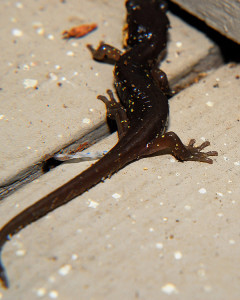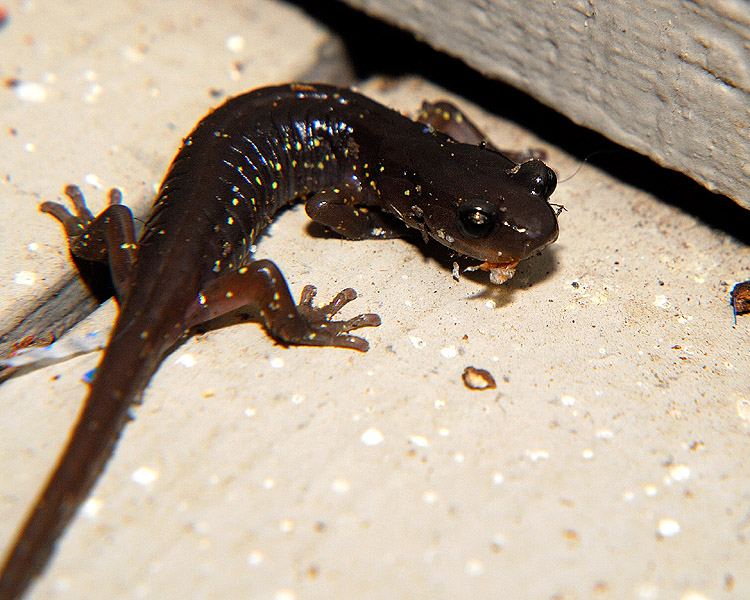With a large, and persistent Pacific storm lashing the coast of California in recent days, there’s enough water running everywhere to make me think I’m going to sprout gills and webbed toes. It’s rained 17 of the first 20 days in December, although our rainy month traditionally isn’t until February.
All this wet weather has brought out the usual suspects. Slugs slithering across paths and up walls, newts and salamanders scrabbling over logs and rocks. Yesterday though, in between rain squalls, we met someone new.


Hiding underneath our canvas firewood bag sitting on the front porch, it looked like even this little fellow was seeking refuge from yesterday’s deluge!
In previous years we’ve seen plenty of Coast Range Newts, and at the moment there are numerous California Slender Salamanders hiding under the brush on the orchard slope. We’ve never before seen Arboreal Salamanders (Aneides lugubris) here though.
Arboreal Salamanders are endemic to California, ranging from Humbolt County in California south to Baja, and east in the Sierra Nevada foothills from El Dorado County to Madera County.
This seemed to be a shy adult, measuring approximately 3 inches long. Adults typically range from 2.25-4 inches in length from nose to vent. This is the largest species within the genus Aneides. When threatened they may hiss or bite, or as was the case with this individual, simply flee.
Arboreal Salamanders are typically brown in coloration with cream to yellow spots. The size of the spots seems to be regionally variable. This mainland specimen has very small spots, whereas the specimens found on the Farallon Islands have large conspicuous spots. [1] Spots may be absent in some populations in the Sierra Nevada foothills. Spot patterns are unique to each individual, serving as a fingerprint of sorts, and can be used by individuals who study them as a means of identification.


Unlike our Coast Range Newts, this is a lung-less species of Salamander that respires through its skin. Arboreal Salamanders, like the Slender Salamanders, have conspicuous costal grooves, and this species usually has 15 costal grooves, in addition to two nasolabial grooves.
Their blunt and broad toes are distinctly different to the other salamander species here, and along with their prehensile tails, this species is very well adapted to climbing.
Aneides lugubris is a nocturnal species, emerging at night to hunt for small invertebrates including worms, slugs, spiders, ants, termites (we have no shortage of those), and occasionally they’ve been known to eat slender salamanders (Batrachoseps sp.), like our resident California Slender Salamander. Arboreal Salamanders capture prey with their tongue, which is then brought into the mouth, and crushed with their strong jaws and very very sharp teeth. A word to the wise, if you should encounter Arboreal Salamanders on hikes, leave them alone. They’ve been known to draw blood (really, follow the link, the photo is amazing)! [2] As you can see, Arboreal Salamanders have the most remarkable dentition of any of our Salamander species. So glad I didn’t pick up this little fellow!
Aneides lugubris is a terrestrial species of salamander often found on moist, mossy rocks, under brush piles and rocks, or inside stumps. In spring the females lay 5-24 jelly-coated eggs, like hanging grapes, in moist tree hollows, often in the decaying cavities of live oaks, of which we have quite a few on the property. The young develop completely within the egg, and hatch as fully formed individuals in August to September, often remaining with the parents for some time after they hatch.


With as common as this species apparently is in this part of California, I’m somewhat surprised that we’ve never noticed them here at Curbstone Valley before, except that their nocturnal habit would make them somewhat more difficult to find. Although this species isn’t considered to be threatened in California, there is some concern that due to its dependence on live oaks within its range for aestivation during the dry months, and reproduction, that in time the decline of our oaks due to diseases like Sudden Oak Death, could result in significant habitat loss for this species.
This is just one more reason, in addition to our disappearing Pacific Madrones, not to let the coniferous species here run amok and overwhelm the property. As the vast majority of our oaks seem to be either sick, dead or dying, our attempts to establish some healthy stands of oak here may help to ensure this species continues to call Curbstone Valley Farm home.
With more rain on the way, I’ll be curious to see if we can find any more Arboreal Salamanders lurking here this winter. In the meantime, if anyone has seen the sun lately, could you send some in this direction?
——————–
[1] The Farallon Arboreal Salamander
[2] Aneides lugubris at CaliforniaHerps.com

Your salamander is a bit slimy, but I am sure he is important in the garden ecosystem. I never see them anymore and used to see many of them.
He is a little slimy, but that’s important as he doesn’t have lungs. His moist skin is critical to help facilitate oxygen and carbon dioxide exchange.
Yikes! I was thinking how cute this critter was, until I followed the link you gave. We have many lizards and salamanders in our area. My oldest son loved to catch them when he was young. Fortunately, he never came across one with sharp teeth.
Aren’t those teeth something else! Yeeeeouch! was my first thought!
I have almost the same comment as Deb! Wow! Those are sharp teeth! They look like tiny knives. I’ve never seen a salamander in my garden. It’s too dry. We have toads but that’s about it. You write like a biologist! I always feel I’ve learned something after I read your posts! :o)
We’re very lucky to have them here. It seems we now have at least three salamander species here…I previously thought we only had two. I’d certainly say though that the arboreal salamander is least common of them all here.
Thanks for the swell, informative post!
Most welcome. I had no idea we had them here until yesterday!
My, what tiny teeth he has… Like little shards of broken glass! A fascinating creature. Glad you’re creating a refuge for his ilk.
He does look remarkably vicious for his size. I was impressed with how much blood those teensy weenie teeth managed to draw. I think glass is a good analogy. They look wickedly sharp!
Hi CV,
Lovely photos, as strange as it may sound I can’t help but think how cute it is… But then I am a reptile/amphibian lover!
Have a lovely Christmas 🙂
I agree Liz, I think he’s adorably cute…but that said, I have absolutely no intention of ever picking one up. Unless he/she is in harms way of course. Then I’d glove up and move it. Gloves being key!
What fun! Now I understand why I never saw one after the sad occurrence with Sal – they’re nocturnal! Funny, I didn’t see that information on the websites I checked.
Great photos.
Awww, TM, I don’t think I was following your blog back then, but I went back and read about Sal. Big carbon foot prints are very easily justified in the cause of rescuing such little creatures. Kudos to you!
We saw one of these fellows in our garage, when we lived near Lake Merritt in Oakland. We were surprised to see it, because we were living in such an urban environment.
Did you know that this species is found on the Farrallon Island? Interesting to consider how its ancestors got there.
Always a wealth of learning info visiting, dear Clare! Wishing you the loveliest of holidays … it’s been a joyful year connecting with you 🙂
Great post! I had no idea there were salamanders I should be wary of — they are definitely on my childhood checklist of “things I can pick up.”
Reminds me of the time I picked up a tiny, nonvenomous snake only to have it “skunk” me. Sometimes I learn the hard way.
Sounds like pretty bad rain when even the amphibians are searching for an umbrella. You can trade some of that rain with us, we’re usually having a drought!
Dear Clare, I envy you your rich and diverse wildlife though I’m sure there are some I would not want to meet. Glad you mentioned the teeth, as this Salamander looks so inviting to hold. Long may they thrive in your old oak trees
Cannot send any sun alas but instead wish you a very Happy Christmas and look forward to visiting all at CV in 2011
Laura x
I found one of these under a pot in the garden last year – curious little fellows! Your post was very interesting – thank you.
What a little cutie! Our most common similar critters are the golden-hued Taricha granulosa, the Rough-skinned Newt. They like to march on the blacktop roads after a rainy day in warmer weather, spring and fall. Unfortunately the cars are always there… we drive very carefully when they are afoot. Speaking of rains… wow you have really had so, so much rain. Makes a “mossback” like me here in the NW realize that we have had it pretty easy this year – and this “la Nina” is supposed to be drier down there?! Hmmm. Happy holidays to you and yours – keep cozy!! Bonnie